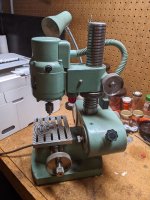Hello,
I'm struggling to identify this piece of equipment I recently picked up. At first, I thought it might be a watchmaker's mill, but it appears to be just a precision micro drill press? Only markings are the motor and the gauges (two gauges - RPM and Table Travel).
The motor is a fractional (1/70th) Bodine NSH-12 R. The gauges are marked Rockford with 1966 and S.L. Gillespie. The table only travels up and down. There is a red light that appears at the 0 mark for table travel, I assume it is for setting a predetermined depth.
Any thoughts are welcome, thanks!
I'm struggling to identify this piece of equipment I recently picked up. At first, I thought it might be a watchmaker's mill, but it appears to be just a precision micro drill press? Only markings are the motor and the gauges (two gauges - RPM and Table Travel).
The motor is a fractional (1/70th) Bodine NSH-12 R. The gauges are marked Rockford with 1966 and S.L. Gillespie. The table only travels up and down. There is a red light that appears at the 0 mark for table travel, I assume it is for setting a predetermined depth.
Any thoughts are welcome, thanks!







